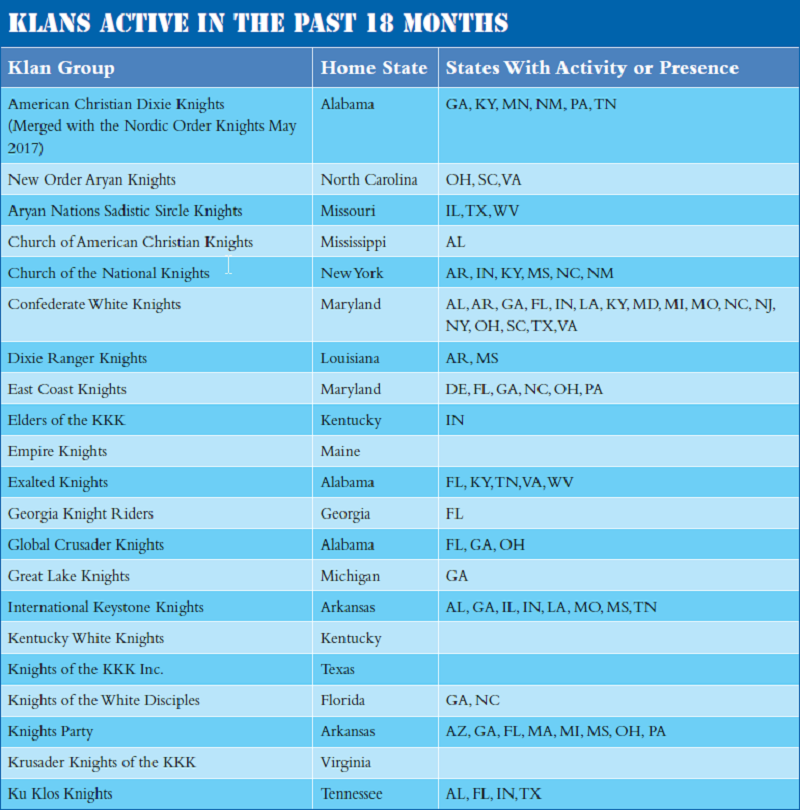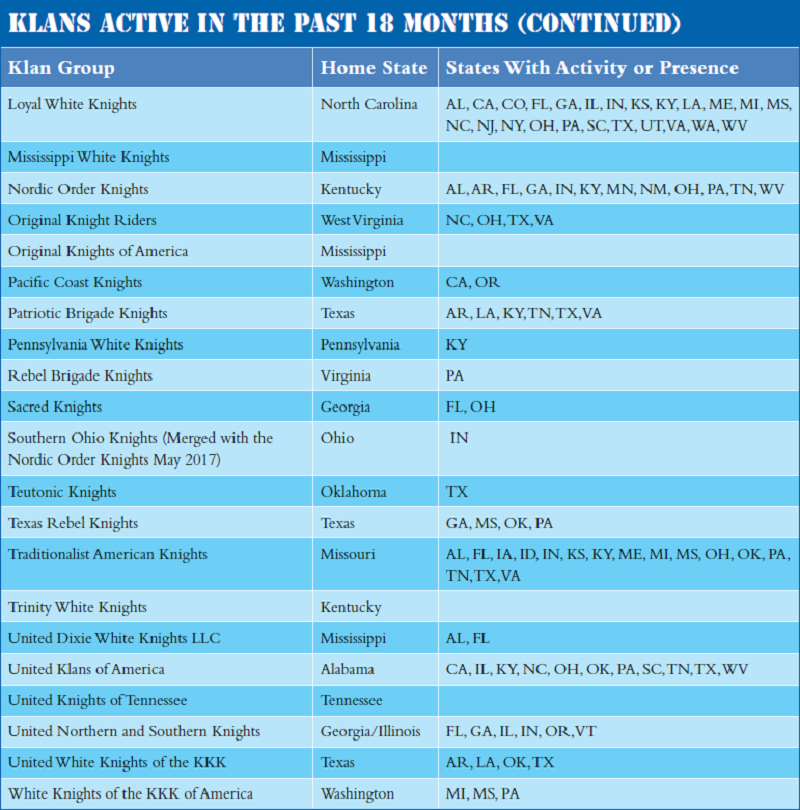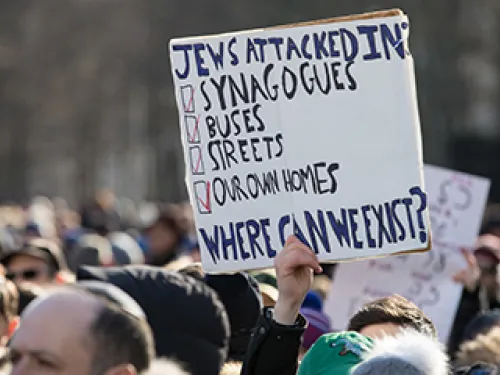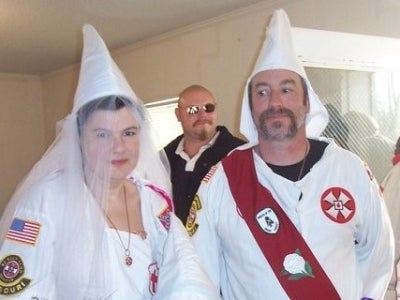Related Content
Read ADL's comprehensive report, Despite Internal Turmoil,Klan Groups Persist (PDF).
As of June 2017, the organized Ku Klux Klan movement in the United States consists of just over 40 active Klan groups, a slight increase from early 2016. More than half of the current Klans have formed in the last three years — a powerful illustration of just how short-lived Klan groups continue to be.
Current Trends
The organized Ku Klux Klan movement continues to struggle due to several factors, including infighting, the perception among adherents that current Klan groups (or their leaders) are not authentic, as well as competition for membership from other white supremacist movements. These include the surging “Alternative right” and a rising number of white supremacist prison gangs.
One of the clearest signs of the declining state of Ku Klux Klan groups is their inability to demonstrate stability or continuity. More than half of the currently active Klan groups were formed or re-started in the last three years. Many of these newly formed Klan groups, led by self-appointed Imperial Wizards (the title for a Klan leader), garner little support from associates or potential members. One Pennsylvania Klansman recently lamented on social media that there were more Imperial Wizards on Facebook than at Hogwarts Academy.
“This is no disrespect to any true IW’s, but there is more Imperial Wizards on Facebook then there is at Hogwarts academy.” 2017 Facebook post by “Joe Mulligan”
Infighting, stimulated by an active rumor mill, also plays a major role in the collective decline of the Ku Klux Klan. The implications of this trend have not been lost on individual Klansmen. The Facebook introduction for Jason O’Hara, former leader of the Alabama-based American Christian Dixie Knights, admits that “With the slander, backstabbing and infighting, we have become our own worst enemy.” A Maine-based Klansman wrote in April 2017, “…these new pop [up] groups and infighting within our ranks hurt our Great Fraternal Organization. If they want to Fight, [they should] Fight for our Race and Children.”
“With the slander, backstabbing and infighting, we have become our own worst enemy.” “Jason O’Hara” 2017 Facebook Intro
Rumors routinely surface about one Klan leader, then another, causing alliances and groups to lose members and splinter. For example, in January 2017 Bradley Jenkins’ Alabama-based United Klans of America (UKA) was banished from the Sadistic Soul’s Black & Silver Alliance following accusations that Jenkins was acting as an informant. After the rumors surfaced and the alliance was broken, several UKA members left and helped form a new group, the Global Crusader Knights. In the same vein, Texas Rebel Knights leader Lonnie “Rowdy” Coats lost members and supporters in December 2016 after someone uncovered and circulated evidence of his 1972 rape conviction. Some of his former members went on to form the Oklahoma-based Teutonic Knights.
In other cases, Klan infighting has gone beyond rumor and innuendo and turned violent, ranging from aggravated assault to murder. In early February 2017, Klanswoman Malissa Ancona was arrested and charged with first-degree murder, tampering with physical evidence and abandonment of a corpse in the murder of her Klan-leader husband, Frank Ancona. The two married in 2010 during a gathering of their Klan group, the Traditionalist American Knights of the Ku Klux Klan.
In December 2016, two leaders of the Loyal White Knights (LWK), Imperial Wizard Christopher Eugene Barker and California Grand Dragon William Ernest Hagen, were arrested on charges related to the alleged felony assault of another man during a gathering at Barker’s home in Yanceyville, North Carolina. The brawl further damaged Barker’s reputation as a leader, after unconfirmed rumors emerged that he acted as an FBI informant against another Klansman, Glendon Scott Crawford. In December 2016, Crawford was sentenced to 30 years in federal prison for planning to use a radiation dispersal device to kill Muslims and Barack Obama.
Nationwide, there are still approximately 3,000 Klan members and unaffiliated individuals who identify with Klan ideology — but turnover and lack of stability have diminished most groups’ numbers. Even the largest Klans don’t appear to have many more than 50 to 100 active members, and most Klans have fewer than 25 members. In an attempt to bolster the appearance of unity and strength, some Klan groups have formed alliances with one another and joined forces with other white supremacist groups.
Approximately half of the currently active Klan groups subscribe to the beliefs of “traditional” white supremacists, the oldest segment of the white supremacist movement and which emerged out of opposition to civil rights for African-Americans. Such Klan members are predominantly anti-black, anti-immigration and homophobic. These groups are unwilling to associate with neo-Nazis or neo-Nazi groups. However, a growing number of Klans, approximately forty percent, promote a Klan ideology infused with neo-Nazi beliefs. The remaining ten percent are adherents of Christian Identity, a longstanding racist and anti-Semitic religious sect.
Members, associates, and supporters of the Klan are focused on their perceived threats to the white race, including the Black Lives Matter movement, Islam and the building of mosques, the LGBT community (particularly transgender restrooms), “black on white crime,” immigration (particularly Mexican), and the threatened removal of Confederate symbols from public spaces such as government buildings, parks, and schools.
The distribution of racist, anti-Semitic, homophobic and Islamophobic fliers remains the most consistent Klan activity. From 2014 through 2016, the Anti-Defamation League tracked an average of 79 incidents per year in which Klan fliers were left on doorsteps or driveways in neighborhoods around the country. The Loyal White Knights are by far the most active fliering group; they are responsible for nearly half (128 out of 274 incidents) of the Klan leafletting efforts since January 2014.
In addition to LWK, at least eight additional Klans have distributed fliers in 2017, including the American Christian Knights, Confederate White Knights, East Coast Knights, International Keystone Knights, Mississippi White Knights, Sacred Knights, Traditionalist American Knights, and the United Northern and Southern Knights.
In contrast to fliering efforts, Klan groups have been unable to show strength in number during public appearances. As of mid-June, this year, there have been three instances in which Klan groups have organized public rallies. In each case, the events were poorly attended even with the benefit of multiple Klan groups participating.
- Madison, Indiana, May 27, 2017: Approximately 15 members and supporters of the Nordic Order Knights and the Southern Ohio Knights briefly rallied at Fireman’s Park.
- Stuart, Virginia, June 10, 2017: Approximately 12 members and supporters of the Rebel Brigade Knights and the Confederate White Knights rallied in front of the Patrick County Court house.
- Florence, Alabama, June 11, 2017: Approximately ten members and supporters of the Global Crusaders, the Exalted Knights and the International Keystone Knights protested an LGBTQ pride march.
The White Knights of the KKK of America (also known as the North Mississippi White Knights) promised a March 2017 demonstration at the Douglas County courthouse in Douglasville, Georgia, meant to protest lengthy sentences given to a Georgia couple following their conviction for threatening an African-American family during a child’s birthday party in July 2015. But the Klan was a no-show.
In other public appearances this year, a small number of Klan members have participated in events organized by other white supremacist groups. In May, Knights Party leader Thomas Robb and several of his members joined an Anti-fa protest organized by the League of the South in Harrison, Arkansas.
While in April, Bill Riccio along with five other Alabama members of the Global Crusader Knights participated in a neo-Nazi rally in Pikeville, Kentucky. Riccio (aka William Davidson) is a long-time white supremacist who gained notoriety in the early 1990’s as a leader of the racist skinhead movement.
The largest public appearance of Klan groups in 2016 occurred at a neo-Nazi event, during the neo-Nazi National Socialist Movement’s (NSM) annual April rally. Approximately 40 associates of the Loyal White Knights and the Texas Rebel Knights joined the NSM as they rallied in Rome, Georgia. Following this public rally, participants gathered for a private meeting and formed the Aryan Nationalist Alliance (ANA), a white supremacist umbrella group later renamed the Nationalist Front. According to the NSM's website, the umbrella alliance currently consists of approximately 20 small white supremacist groups, including three Klan groups: the Texas Rebel Knights, the Pacific Coast Knights, and the Nordic Order Knights.

Klan members stand in front of the Law Enforcement Center in Rome, Georgia, April 2016
Five months later, on November 5, the NSM held its Fall rally on the steps of Pennsylvania’s capitol building in Harrisburg, this time drawing approximately 15 associates of the White Knights of the KKK of America and Texas Rebel Knights.
The largest Klan-organized public event in 2016 occurred on September 24 when approximately 10 members and associates of the Confederate White Knights (CWK) rallied at Fireman’s Park in Madison, Indiana. During the event CWK leaders Imperial Wizard Richard Preston and Indiana Grand Dragon Anthony “Tony” Berry delivered speeches that addressed government tyranny, bullying, and stopping drug abuse (with violence if necessary). They also denounced the Black Lives Matter movement.
Klan members continue to be linked to criminal activity and violence. In addition to the February arrest of Malissa Ancona, there have been several notable arrests of Klan members in 2017. In January, five members and associates of the White Knights of the Ku Klux Klan of America were arrested on robbery charges in Union County, Mississippi. According to Sheriff Jimmy Edwards, a female suspect lured the victim to a church parking area where he was threatened and robbed of his cell phone and wallet.

Benjamin McDowell in red participates in Klan initiation ritual, 2015
Another arrest occurred in South Carolina in February, when FBI agents arrested Benjamin Thomas Samuel McDowell of Conway, South Carolina, alleging he’d purchased a gun from an undercover FBI agent who was posing as someone connected with a faction of the neo-Nazi group Aryan Nations. McDowell, a convicted felon not allowed to own guns, was charged with illegal possession of a firearm. According to authorities, McDowell also indicated to the agent that he was interested in committing a “Dylann Roof-style” violent attack. He was a member of the Alabama-based United Klans of America.
Klans that were active in the past 18 months, their home state(s), and the states where they have a presence:












